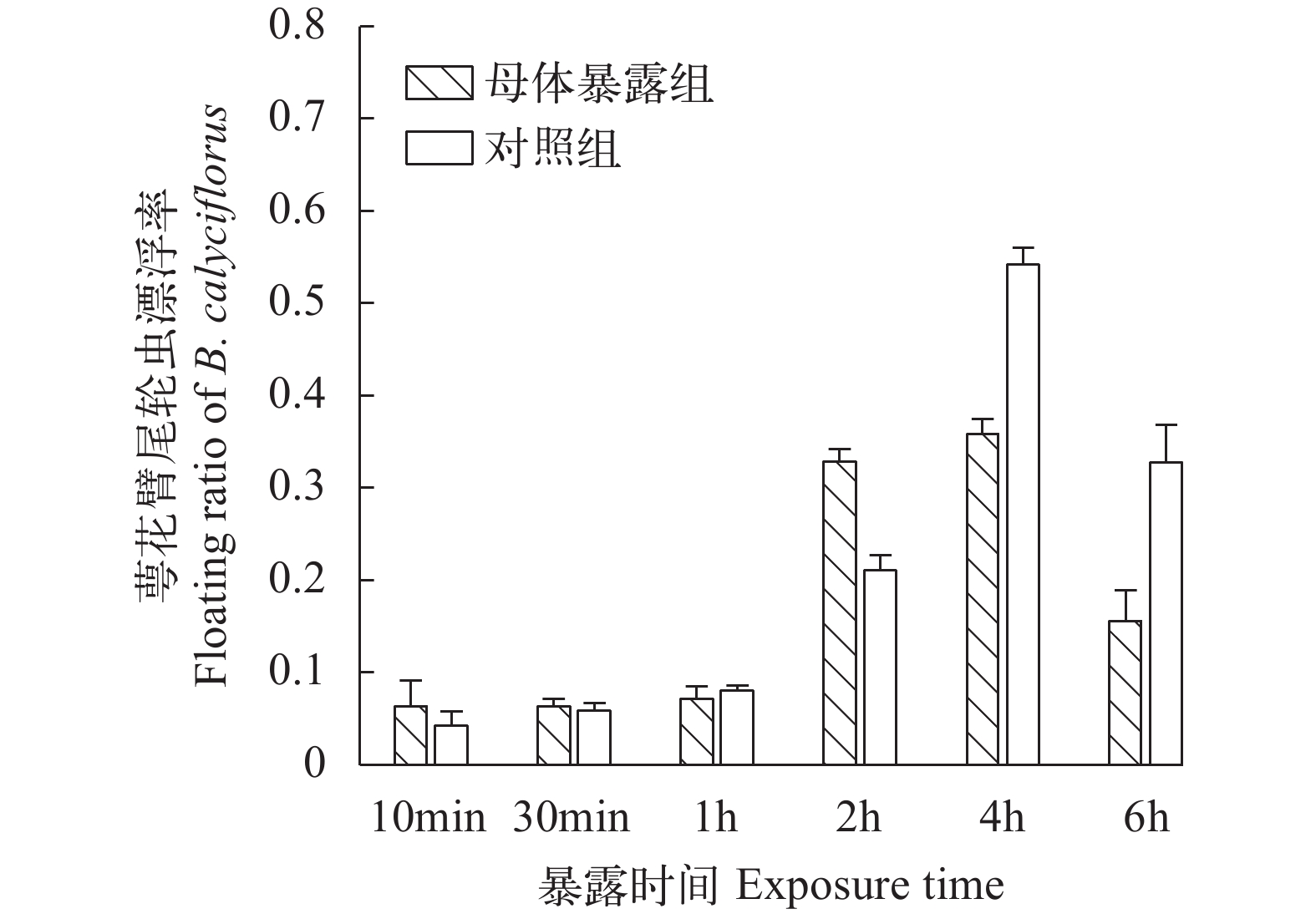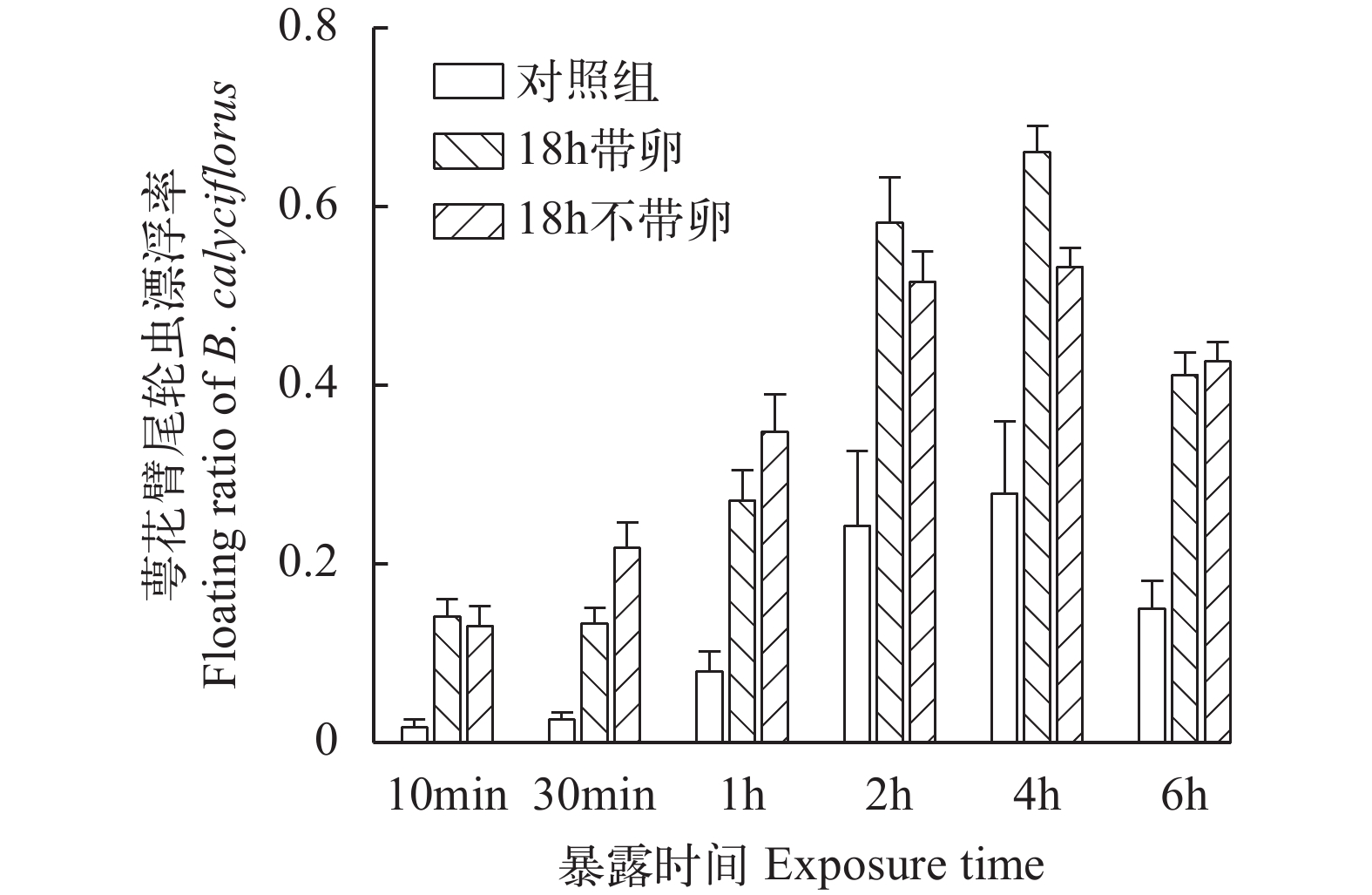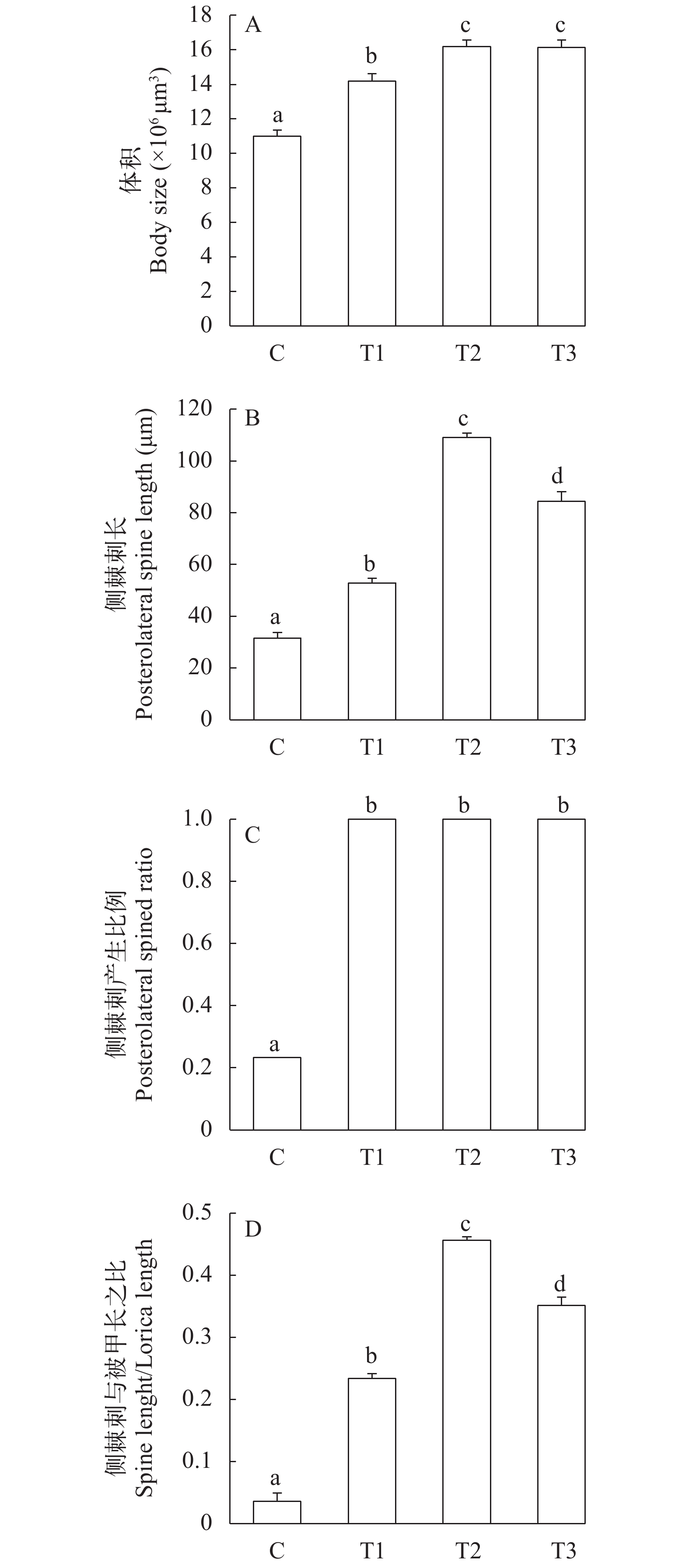THE MATERNAL EFFECT OF ANTI-PREDATOR BEHAVIOURAL AND MORPHOLOGICAL RESPONSES TO ASPLANCHNA IN BRACHIONUS CALYCIFLORUS
-
摘要: 为研究轮虫通过母体效应诱导能否产生行为响应, 以萼花臂尾轮虫(Brachionus calyciflorus)为例, 研究其反捕食漂浮行为响应的母体效应。通过控制轮虫母体在捕食者诱导液中的暴露时间及带卵状态, 收集母体产生的后代, 再将这些后代再次用捕食者诱导液处理, 观察后代的漂浮行为及形态特征。研究发现: 暴露于捕食者诱导液诱导较长时间的母体产生的后代个体, 当再次暴露于捕食者诱导液时, 其产生的行为响应强于没有母体暴露经历的后代; 母体暴露时间越长, 后代形态和行为响应均更加强烈。研究显示萼花臂尾轮虫可通过母体效应产生漂浮行为响应。Abstract: Predation is vital in regulating population and community structure in aquatic ecosystems. When predators exist, many organisms can reduce the risk of predation by generating specific anti-predator responses. Therefore, one pivotal goal in ecology is to investigate how prey respond to particular predators, and how prey pass the predator stress on to offspring. In Monogononta, Phylum Rotifera, when coexisting with predators, some rotifers are able to exhibit morphological, behavioural or life-history responses. And rotifer individuals without direct predator experience can exhibit morphological anti-predator defences via maternal effects. But no study has so far investigated if the behavioural anti-predator response could be triggered via maternal effect. Hence, in this study, we used B. calyciflorus as the model organism to investigate whether its floating behavioural response could be triggered through maternal effect. We hypothesized that B. calyciflorus individuals with maternal predator experience could express stronger floating behaviour when exposed to the predator. In the experiments, we independently investigated the effect of exposure time (2h and 18h) and oocyte status (with and without eggs) of B. calyciflorus on the floating behaviour or morphology of their offspring when re-expose the offspring to predator kairomone. Our results suggested that (1) when expose to Asplanchna predator kairomone, the rotifer offspring with maternal long time exposure experience (18h exposure) have higher proportion floating to the water surface than individuals without maternal experience; (2) the intensity of anti-predator morphological and behavioural responses depends on the maternal exposure time when the mother generation exposed to predator kairomone for longer time, the offspring would exhibit both stronger morphological and behavioural responses. Our results provide novel evidence that behavioural anti-predator response could be affected by maternal effect.
-
捕食与被捕食关系是组成食物网结构的基础[1, 2]。捕食压力能诱导生物产生特异性反捕食响应, 如行为、形态、生理生化和生活史响应等。这些响应可降低生物被捕食的风险, 或者增加生物与捕食者接触后的逃脱率[3-7]。因此, 研究反捕食响应有助于深入理解食物网中不同生物间的互动机制, 为预测食物网动态提供支持。
轮虫体型微小, 分布广泛, 具有较高的生物量及年周转量[8, 9], 是许多水生动物的重要食物源。轮虫连接初级生产者和较高营养级, 其与捕食者的互动关系具有重要的研究意义。目前已知至少19种轮虫可产生特异性反捕食响应[10-13], 包括形态响应(产生棘刺、增加或缩小体型等)、生活史响应(产生更多或更少的幼体、改变后代性别比例等), 以及行为响应(产生附着、躲避或漂浮行为)[14-18]。但现有研究多数是关于特异性的形态变化及伴随产生的生活史特征变化[19, 20], 对于反捕食行为响应研究较少。直到最近才有研究显示轮虫除形态响应之外, 还可产生行为响应[18]。例如, 捕食者晶囊轮虫 (Asplanchna) 可使变异臂尾轮虫 (Brachionus variabilis) 增大体型, 并增加附着在物体表面的比例[21]; 红臂尾轮虫 (B. rubens) 虽然没有反捕食形态响应, 但晶囊轮虫可使其增加表面附着比例[13]。西氏晶囊轮虫 (A. sieboldi) 可使萼花臂尾轮虫 (B. calyciflorus) 迅速漂浮至水体表面并保持一定时间[18]。
除直接接触捕食者, 产生响应之外, 轮虫还能通过母体效应产生形态及生活史响应[22, 23]。例如, 经捕食者刺激并移除刺激物质可使臂尾轮属轮虫产生具有反捕食形态的后代[16, 22]。在面临捕食者时, 这种通过母体效应产生的防御形态可让体型较小的轮虫在接触捕食者后成功逃脱。但除形态响应之外, 轮虫反捕食行为响应能否通过母体效应产生仍然未知。
萼花臂尾轮虫分布广泛, 关于其对生物或非生物环境因素的响应已有许多报道[24-26]。在这些研究基础上, 本文以萼花臂尾轮虫 (B. calyciflorus) 为被捕食者, 以卜氏晶囊轮虫 (A. brightwellii) 为捕食者, 设计实验研究萼花臂尾轮虫能否通过母体效应产生行为响应。目前已知捕食者诱导液可能通过三种途径诱导轮虫产生反捕食响应(直接作用于轮虫卵细胞表面受体; 渗透卵细胞, 对幼体产生作用; 影响母体, 使其产生具有反捕食响应的后代)[10]。此外, 轮虫在捕食者诱导液中暴露的时间长短也会影响轮虫形态及生活史特征[19]。考虑到不同的诱导途径及作用时间可能产生的影响, 我们通过实验设计, 将处于不同带卵状态的萼花臂尾轮虫放入捕食者诱导液中暴露不同时间后, 将轮虫从诱导液中取出, 放入正常培养液培养。待这批轮虫产生后代, 收集后代并将后代再次暴露在捕食者诱导液中, 对比这批后代与未经捕食者诱导的母体产生的后代的漂浮行为差异及形态差异, 并分析行为和形态响应与不同诱导途径及作用时间的关系, 为种间关系与母体效应的联系研究提供基础。
1. 材料与方法
1.1 实验材料
萼花臂尾轮虫由采集自武汉下涉湖(北纬: 30°8′35″, 东经: 114°10′20″)的休眠卵孵化而得。在轮虫孵化后, 随机挑选一个非混交个体于EPA培养液中进行单克隆繁殖[27], 获得萼花臂尾轮虫种群。捕食者卜氏晶囊轮虫采集自保安湖(北纬: 30°14′39″, 东经: 114°43′37″), 随机挑选一个非混交个体用EPA培养液中进行单克隆繁殖, 获得卜氏晶囊轮虫种群。
在日常培养及正式实验中, 在BG-11培养液中培养小球藻(Chlorella sp., FACHB-1067, 中国科学院水生生物研究所淡水藻种库)并用其投喂萼花臂尾轮虫[28], 喂养密度约为1×106 个/mL。再用培养的萼花臂尾轮虫投喂卜氏晶囊轮虫, 喂养密度约为10 只/mL。所有轮虫及小球藻均在恒温光照培养箱中培养, 光照周期(光﹕暗)为14h﹕10h, 光照强度为1500 lx, 培养温度为(24±1)℃。在正式实验之前, 所有的轮虫均在适宜生长条件下的光照培养箱内培养至少1个月, 并保证实验时轮虫种群处于指数增长期。
所有实验均采用卜氏晶囊轮虫诱导液模拟捕食者存在的情况, 以免捕食者摄食影响观测结果。在实验正式开始前12h, 在500 mL EPA培养液中放入40只大小相当的晶囊轮虫个体(浓度: 80只/L), 并投喂随机挑选的萼花臂尾轮虫(1000 只/L), 12h后过0.2 μm滤网, 收集得到捕食者诱导液。正式实验时, 用EPA培养液将诱导液浓度稀释至40只/L使用。在所有实验中, 小球藻添加密度均为1×106 个/mL。所有实验均在(24±1)℃的室内进行。
1.2 实验一: 萼花臂尾轮虫短期暴露于捕食者诱导液后, 后代个体再次暴露于捕食者诱导液中的行为响应
本实验研究萼花臂尾轮虫母体在捕食者诱导液中暴露2h后, 后代个体再次暴露于捕食者诱导液时, 与没有母体暴露经历的个体的后代相比, 能否产生更强烈的漂浮行为。实验分2组, 分别为对照组(母体未暴露于晶囊轮虫诱导液中)、暴露组(母体在晶囊轮虫诱导液中暴露2h)。随机挑选约1000只未带卵萼花臂尾轮虫, 并等分为两批, 分别放入EPA培养液和捕食者诱导液中培养2h。然后用吸管挑出经捕食者诱导液处理的萼花臂尾轮虫, 并用EPA培养液润洗3遍, 然后放入EPA培养液中。随后, 每隔2h观察母体的繁殖情况, 待有大量新生幼体孵化后, 分别收集对照组和暴露组中产生的幼体。每一组设置8个平行样品, 每1平行样品含30只幼体, 将对照组和暴露组的幼体分别放入50 mL晶囊轮虫诱导液中并混匀。待所有轮虫放入后10min、30min、1h、2h、4h及6h用显微镜 (SOPTOP SZ) 于6.7倍下观察并统计漂浮于水面的轮虫个体。在观察结束后, 立即用鲁哥试剂固定所有轮虫, 统计每一平行样中轮虫数量, 随后计算实验过程中不同观察时间段内轮虫的漂浮率。
1.3 实验二: 萼花臂尾轮虫较长时间暴露于捕食者诱导液后, 后代个体的行为响应
本实验研究萼花臂尾轮虫在晶囊轮虫诱导液中暴露18h后, 后代个体再次暴露于捕食者诱导液时, 与没有母体暴露经历的个体相比, 能否产生更强烈的漂浮行为。本实验共设置3组, 分别为对照组(母体未暴露于晶囊轮虫诱导液中)、18h不带卵暴露组(轮虫母体在晶囊轮虫诱导液中暴露18h后, 挑选出仍处于未带卵状态的萼花臂尾轮虫并放回EPA培养液中)及18h带卵暴露组(将轮虫母体在晶囊轮虫诱导液中暴露18h后, 挑选已带卵的个体, 并放回EPA培养液中)。由于每1组所需轮虫较多, 同时观察较多数量可能产生混淆, 因此本实验将经18h诱导处理后带卵与不带卵样品分两次进行实验, 记为子实验1和子实验2, 以减小挑选时间可能带来的影响。
与1.2的实验设计类似, 子实验1中, 随机挑选约1000只未带卵萼花臂尾轮虫, 均分为两批, 分别放入EPA培养液和晶囊轮虫诱导液中培养18h。期间, 每隔2h观察萼花臂尾轮虫带卵情况。18h后, 用吸管挑出诱导液中已经带卵的轮虫, 用EPA培养液润洗3遍, 除去可能残余的诱导液后, 放入EPA培养液中培养。随后步骤与1.2相同。子实验2与子实验1类似, 但在将母体暴露18h后, 挑选未带卵萼花臂尾轮虫, 用EPA培养液润洗3遍后, 放入EPA培养液中培养。随后步骤同1.2所述。
1.4 实验三: 母体于捕食者诱导液中暴露时间及带卵状态对萼花臂尾轮虫后代形态特征影响
实验前, 挑选约1000只未带卵萼花臂尾轮虫, 并将轮虫分为四组: 分别为对照组(C, 用EPA培养液处理萼花臂尾轮虫母体)、短期暴露组(T1, 萼花臂尾轮虫母体于捕食者信息素中暴露2h)、长期暴露不带卵组(T2, 萼花臂尾轮虫母体于捕食者信息素中暴露18h后, 收集仍未带卵的个体)和长期暴露带卵组(T3, 萼花臂尾轮虫母体于捕食者信息素中暴露18h后, 收集已带卵的个体), 其中T1与实验一过程相同, T2和T3与实验二过程相同。暴露2h或18h后, 将晶囊轮虫诱导液中的萼花臂尾轮虫用EPA培养液润洗三遍, 放入EPA培养液中, 每2h观察产幼体情况。待有大量新生幼体孵化后, 在不同组中随机挑选新生幼体各30只, 用鲁哥试剂固定并测量被甲长 (Lorica length)、被甲宽 (Lorica width)和后侧棘刺长 (Posterolateral spine length)。通过上述指标计算得出轮虫体积(体积=0.2A2B, 其中A=被甲长, B=被甲宽)、后侧棘刺长度及后侧棘刺与被甲长之比[29]。所有形态测量均在显微镜 (Olympus X41) 及显微镜拍摄系统 (Mshot) 上完成。
1.5 统计分析
在实验一与二中存在重复观测数据, 因此我们用广义线性混合模型分析萼花臂尾轮虫漂浮数据。由于数据不满足正态性, 将轮虫漂浮率进行对数转换后 (lg[(y+ε)/(1–y+ε)], 其中ε为除漂浮率为零之外的最小轮虫漂浮率)[30], 用glmmTMB包中glmmTMB函数的高斯分布分析捕食者诱导液对萼花臂尾轮虫漂浮率的影响(实验一, 固定变量: 不同诱导液处理; 实验二, 固定变量: 不同诱导液处理, 母体带卵状态。两组实验随机变量: 不同平行及观测时间), 并用lsmeans包中的Tukey’s HSD对不同处理进行两两比较。实验三采用方差分析 (ANOVA) 统计母体暴露时间长短与幼体体积的关系, 并用广义线性模型 (GLM) 分析不同母体暴露时间及状态处理后侧棘刺长度的差异是否具有显著性。用非参数检验 (Kruskal-Wallis test) 统计不同处理轮虫幼体产生棘刺的比例。所有分析均在R 4.0.4中完成 [31]。
2. 结果
2.1 母体短期暴露于捕食者诱导液中对萼花臂尾轮虫后代再次暴露于捕食者时的行为影响
萼花臂尾轮虫母体在晶囊轮虫诱导液中暴露2h后, 其后代个体再次暴露于捕食者诱导液中时, 漂浮率与没有母体暴露经历的个体相比, 没有显著差异(图 1, GLMM, z=–0.280, P=0.779)。
2.2 萼花臂尾轮虫母体长期暴露在捕食者诱导液中对后代再次暴露于捕食者诱导液中的行为影响
当萼花臂尾轮虫在卜氏晶囊轮虫诱导液中暴露18h后, 无论在暴露过程中是否形成卵, 其产生的后代与对照组(没有母体暴露经历的后代)相比, 当放入捕食者诱导液中时, 均表现出更强烈的漂浮行为响应 (表 1与图 2)。但暴露相同时间后 (18h), 母体是否带卵不影响后代的漂浮率(Tukey’s HSD, t=0.011, P=0.999)。
表 1 实验二GLMM统计结果Table 1. GLMM result for experiment 2处理 Treatment 统计量Estimate SE z 18h带卵
18h oocyte0.629 0.048 13.186*** 18h 不带卵
18h non-oocyte0.629 0.048 13.196*** 注: 萼花臂尾轮虫母体在晶囊轮虫捕食者诱导液中暴露18h后, 取出时带卵状态对后代个体再次暴露于捕食者诱导液时的漂浮响应; ***P<0.001; 下同Note: Effects of 18h maternal exposure (oocyte or non-oocyte) on the floating response of the Brachionus calyciflorus offspring when re-exposed to Asplanchna kairomone. ***P<0.001. The same applies below 2.3 萼花臂尾轮虫母体在捕食者诱导液中暴露不同时间后, 后代的形态特征
萼花臂尾轮虫母体在晶囊轮虫诱导液中暴露不同时间后, 产生的后代体积具有差异(图 3)。母体暴露时间越长, 产生的后代平均体积越大(图 3A)。暴露相同时间时 (18h), 母体是否带卵对后代体型无显著影响(图 3B)。但母体暴露时间及带卵状态可显著影响后代的后侧棘刺长度(图 3B与表 2)。其中, 母体长时间暴露于捕食者诱导液中且在诱导液中形成卵后, 产生的幼体后侧棘刺最长, 且这一组后代具有最大的后侧棘刺与被甲长度比(图 3D)。此外, 无论暴露时间长短, 捕食者诱导后的母体产生的幼体均具有后侧棘刺(图 3C, Kruskal-Wallis test, P<0.001)。
表 2 母体暴露不同时间后, 后代个体后侧棘刺长度多重比较差异Table 2. Multiple comparison result of different maternal exposure time on the posteralateral spine length of offspring处理 Treatment 统计量Estimate SE t value 2h处理
2h exposure–0.013 0.003 –5.009*** 18h不带卵
18h oocyte–0.023 0.002 –9.101*** 18h带卵
18h nonoocyte–0.020 0.002 –7.966*** 注:*代表统计显著性差异,***P<0.001Note: *represent siqnificantly different level,***P<0.001 ![]() 图 3 萼花臂尾轮虫母体于捕食者诱导液中暴露2h(T1)、18h带卵(T2)、18h不带卵(T3)及未暴露(C)后, 后代个体的形态特征A. 萼花臂尾轮虫后代个体体积; B. 萼花臂尾轮虫后代个体侧棘刺长度; C. 不同处理后代个体产生棘刺的比例; D. 后侧棘刺与被甲长之比. 图中小写英文字符代表显著性差异Figure 3. The effect of pre-exposure in Brachionus calyciflorus parental generation for 2h (T1), 18h oocyte (T2), 18h non-oocyte (T3) and control (C) treatment on the morphological response in their offspring generationA. Body size of the offspring; B. Posterolateral spine length of the offspring; C. Posterolateral spined ratio of the offspring; D. The ratio of posterolateral spine length to lorica length. Significances are indicated by the lower case
图 3 萼花臂尾轮虫母体于捕食者诱导液中暴露2h(T1)、18h带卵(T2)、18h不带卵(T3)及未暴露(C)后, 后代个体的形态特征A. 萼花臂尾轮虫后代个体体积; B. 萼花臂尾轮虫后代个体侧棘刺长度; C. 不同处理后代个体产生棘刺的比例; D. 后侧棘刺与被甲长之比. 图中小写英文字符代表显著性差异Figure 3. The effect of pre-exposure in Brachionus calyciflorus parental generation for 2h (T1), 18h oocyte (T2), 18h non-oocyte (T3) and control (C) treatment on the morphological response in their offspring generationA. Body size of the offspring; B. Posterolateral spine length of the offspring; C. Posterolateral spined ratio of the offspring; D. The ratio of posterolateral spine length to lorica length. Significances are indicated by the lower case3. 讨论
许多生物可通过母体效应产生反捕食防御[32—34] 。例如, 经捕食者幽蚊 (Chaoborus flavicans) 诱导处理的僧帽溞 (Daphnia cucullata) 产生的后代具有更大的头盔 (Helmet) [35]。经晶囊轮虫诱导的臂尾轮虫产生的后代具有较长的棘刺[22, 23]。此外, 与没有经捕食者诱导处理的个体相比, 诱导处理的母体产生的休眠卵孵化后产生的防御性棘刺较短[36]。这些结果表明生物可通过母体效应产生反捕食形态响应。近年来也有研究发现生物可通过母体效应产生行为响应[37, 38]。例如, 经捕食者诱导处理的蟋蟀母体产生的后代具有更强的反捕食移动能力[38]。我们的研究同样为这一观点提供了有力论据, 即经捕食者诱导处理后, 轮虫不仅直接产生行为响应, 也能通过母体效应产生形态防御, 还可通过母体效应产生行为响应。
当萼花臂尾母体短时间 (2h) 暴露于晶囊轮虫捕食者诱导液后, 后代再次暴露在诱导液中的行为与没有母体暴露处理的后代相比, 没有显著差异。而母体曾较长时间 (18h) 暴露于诱导液后产生的后代则具有显著的反捕食漂浮行为。该结果显示通过母体效应产生的幼体漂浮行为强度可能与母体接受的刺激时间相关。在轮虫接受较长时间刺激后, 则可通过母体效应将这种刺激传递给后代, 使后代产生更加强烈的行为响应。
在实验三中, 我们研究了萼花臂尾轮虫母体在捕食者诱导液中暴露时间与后代形态的关系。与前人的研究结果类似, 母体在晶囊轮虫诱导液中暴露时间越长, 后代的形态响应则越强烈。综合前述行为实验, 我们认为轮虫可通过母体效应使后代产生更显著的形态和行为反捕食响应, 因此, 当萼花臂尾轮虫与捕食者共存在时, 共同采用两种响应方式可能提高轮虫幼体的生存率。
许多生物可通过改变形态或行为降低捕食者威胁[39, 40]。目前已知包括软体动物、鱼类、两栖动物及一些陆生动物等均可产生行为或形态反捕食响应[7, 41-43]。这些响应除了改变生物自身的形态或行为特征, 还可改变生物与捕食者的种间关系, 最终通过上行或下行效应影响食物网甚至生态系统[39, 44]。近年来随着气候变化加剧, 极端天气增加, 种间关系可受到气候变化影响, 在不同生物间形成资源错配[45]。例如, 桡足类和轮虫对气候变化的适应程度不同, 升温可加强桡足类对轮虫的摄食作用, 降低轮虫在水体中的丰度[46]。在不利条件下, 与形态响应相比, 行为响应发生时间较短, 在外界环境改变或者恢复后, 行为响应可迅速逆转, 因此行为响应对于生物适应不利环境具有重要意义[47]。在特定情况下, 生物通过行为响应, 逃离捕食者或渡过不利环境后, 才有机会产生形态或者生活史响应[48]。在极端气候增加的情况下, 行为响应可能是决定生物体能否生存的关键响应。本文首次发现轮虫可通过母体效应产生反捕食行为响应, 这一结果也显示轮虫对不利的外部条件具有更灵活的适应能力, 为未来的种间关系与母体效应的联系研究提供了基础。
4. 结论
本研究在萼花臂尾轮虫的反捕食漂浮行为研究基础上, 首次通过实验研究了轮虫母体效应与反捕食漂浮行为的关系。发现: (1)经捕食者诱导液处理较长时间后的母体, 无论是否带卵, 再放入普通培养液后, 产生的幼体当暴露于同种捕食者诱导液时, 产生的漂浮行为响应比没有经捕食者诱导液处理的母体产生的幼体更强烈; (2)母体于捕食者诱导液中暴露时间越长, 后代反捕食行为响应与形态响应均更加强烈。在未来的种间关系研究中, 可以进一步研究捕食者密度、与母体共存时间及其他如气候变化等环境因素对轮虫反捕食行为母体效应的影响, 以及这种响应对轮虫自身种群结构及其与环境互动的影响。
-
图 3 萼花臂尾轮虫母体于捕食者诱导液中暴露2h(T1)、18h带卵(T2)、18h不带卵(T3)及未暴露(C)后, 后代个体的形态特征
A. 萼花臂尾轮虫后代个体体积; B. 萼花臂尾轮虫后代个体侧棘刺长度; C. 不同处理后代个体产生棘刺的比例; D. 后侧棘刺与被甲长之比. 图中小写英文字符代表显著性差异
Figure 3. The effect of pre-exposure in Brachionus calyciflorus parental generation for 2h (T1), 18h oocyte (T2), 18h non-oocyte (T3) and control (C) treatment on the morphological response in their offspring generation
A. Body size of the offspring; B. Posterolateral spine length of the offspring; C. Posterolateral spined ratio of the offspring; D. The ratio of posterolateral spine length to lorica length. Significances are indicated by the lower case
表 1 实验二GLMM统计结果
Table 1 GLMM result for experiment 2
处理 Treatment 统计量Estimate SE z 18h带卵
18h oocyte0.629 0.048 13.186*** 18h 不带卵
18h non-oocyte0.629 0.048 13.196*** 注: 萼花臂尾轮虫母体在晶囊轮虫捕食者诱导液中暴露18h后, 取出时带卵状态对后代个体再次暴露于捕食者诱导液时的漂浮响应; ***P<0.001; 下同Note: Effects of 18h maternal exposure (oocyte or non-oocyte) on the floating response of the Brachionus calyciflorus offspring when re-exposed to Asplanchna kairomone. ***P<0.001. The same applies below 表 2 母体暴露不同时间后, 后代个体后侧棘刺长度多重比较差异
Table 2 Multiple comparison result of different maternal exposure time on the posteralateral spine length of offspring
处理 Treatment 统计量Estimate SE t value 2h处理
2h exposure–0.013 0.003 –5.009*** 18h不带卵
18h oocyte–0.023 0.002 –9.101*** 18h带卵
18h nonoocyte–0.020 0.002 –7.966*** 注:*代表统计显著性差异,***P<0.001Note: *represent siqnificantly different level,***P<0.001 -
[1] Posey M H, Hines A H. Complex predator-prey interactions within an estuarine benthic community [J]. Ecology, 1991, 72(6): 2155-2169. doi: 10.2307/1941567
[2] Sih A, Crowley P, McPeek M, et al. Predation, competition, and prey communities: a review of field experiments [J]. Annual Review of Ecology and Systematics, 1985(16): 269-311.
[3] Yin X W, Zhou Y C, Li X C, et al. Reduced investment in sex as a cost of inducible defence in Brachionus calyciflorus (Rotifera) [J]. Freshwater Biology, 2015, 60(1): 89-100. doi: 10.1111/fwb.12469
[4] Boersma M, Spaak P, De Meester L. Predator-mediated plasticity in morphology, life history, and behavior of Daphnia: the uncoupling of responses [J]. The American Naturalist, 1998, 152(2): 237-248. doi: 10.1086/286164
[5] Turner A M, Bernot R J, Boes C M. Chemical cues modify species interactions: the ecological consequences of predator avoidance by freshwater snails [J]. Oikos, 2000, 88(1): 148-158. doi: 10.1034/j.1600-0706.2000.880117.x
[6] Hoverman J T, Relyea R A. Survival trade-offs associated with inducible defences in snails: the roles of multiple predators and developmental plasticity [J]. Functional Ecology, 2009, 23(6): 1179-1188. doi: 10.1111/j.1365-2435.2009.01586.x
[7] Brönmark C, Miner J G. Predator-induced phenotypical change in body morphology in crucian carp [J]. Science, 1992, 258(5086): 1348-1350. doi: 10.1126/science.258.5086.1348
[8] Williamson C E. Invertebrate predation on planktonic rotifers [J]. Hydrobiologia, 1983, 104(1): 385-396. doi: 10.1007/BF00045996
[9] 王雨路, 袁丹妮, 袁国庆, 等. 武汉东湖夏冬两季浮游动物物种多样性及群落结构研究 [J]. 水生生物学报, 2020, 44(4): 877-894. doi: 10.7541/2020.105 Wang Y L, Yuan D N, Yuan G Q, et al. Species diversity and community structure of zooplankton in summer and winter in the East Lake, Wuhan [J]. Acta Hydrobiologica Sinica, 2020, 44(4): 877-894. doi: 10.7541/2020.105
[10] Gilbert J J. Non-genetic polymorphisms in rotifers: environmental and endogenous controls, development, and features for predictable or unpredictable environments [J]. Biological Reviews, 2017, 92(2): 964-992. doi: 10.1111/brv.12264
[11] 何雨晗, 徐军, 姚慧, 等. 轮虫表型可塑性及其生态学效应研究进展 [J]. 水生生物学报, 2020, 44(5): 998-1007. doi: 10.7541/2020.115 He Y H, Xu J, Yao H, et al. Review on phenotypic plasticity of rotifers and its ecological effects [J]. Acta Hydrobiologica Sinica, 2020, 44(5): 998-1007. doi: 10.7541/2020.115
[12] 殷旭旺, 赵文, 毕进红, 等. 卜氏晶囊轮虫对4种臂尾轮虫形态可塑性的影响 [J]. 大连水产学院学报, 2009, 24(6): 493-496. Yin X W, Zhao W, Bi J H, et al. Rotifer Asplanchna brightwellii induced morphological plasticity in four Brachionus rotifer species [J]. Journal of Dalian Fisheries University, 2009, 24(6): 493-496.
[13] Gilbert J J. Attachment behavior in the rotifer Brachionus rubens: induction by Asplanchna and effect on sexual reproduction [J]. Hydrobiologia, 2019, 844(1): 9-20. doi: 10.1007/s10750-018-3805-7
[14] Gilbert J J, Waage J K. Asplanchna, Asplanchna-substance, and posterolateral spine length variation of the rotifer Brachionus calyciflorus in a natural environment [J]. Ecology, 1967, 48(6): 1027-1031. doi: 10.2307/1934559
[15] Zhang H, Hollander J, Hansson L A. Bi-directional plasticity: Rotifer prey adjust spine length to different predator regimes [J]. Scientific Reports, 2017(7): 10254.
[16] Schröder T, Gilbert J J. Maternal age and spine development in the rotifer Brachionus calyciflorus: increase of spine length with birth orders [J]. Freshwater Biology, 2009, 54(5): 1054-1065. doi: 10.1111/j.1365-2427.2008.02153.x
[17] Yin X W, Jin W, Zhou Y C, et al. Hidden defensive morphology in rotifers: benefits, costs, and fitness consequences [J]. Scientific Reports, 2017(7): 4488.
[18] Zhang H, He Y, He L, et al. Behavioural response of Brachionus calyciflorus to the predator Asplanchna sieboldii [J]. Freshwater Biology, 2021, 66(3): 562-569. doi: 10.1111/fwb.13660
[19] 陈政道, 孙栋, 牛翠娟, 等. 卜氏晶囊轮虫对萼花臂尾轮虫形态及种群生活史对策的短期和长期影响 [J]. 生物学通报, 2013, 48(1): 54-56. doi: 10.3969/j.issn.0006-3193.2013.01.018 Chen Z D, Sun D, Niu C J, et al. Short-term and long-term effects of Asplanchna brightwellii on the morphology and life-history strategies of Brachionus calyciflorus [J]. Bulletin of Biology, 2013, 48(1): 54-56. doi: 10.3969/j.issn.0006-3193.2013.01.018
[20] 殷旭旺, 牛翠娟. 萼花臂尾轮虫多态性及形态型转化 [J]. 动物学研究, 2007, 28(1): 68-72. doi: 10.3321/j.issn:0254-5853.2007.01.012 Yin X W, Niu C J. Polymorphism and morphotype transformations in the rotifer (Brachionus calyciflorus) [J]. Zoological Research, 2007, 28(1): 68-72. doi: 10.3321/j.issn:0254-5853.2007.01.012
[21] Gilbert J J. Morphological and behavioral responses of a rotifer to the predator Asplanchna [J]. Journal of Plankton Research, 2014, 36(6): 1576-1584. doi: 10.1093/plankt/fbu075
[22] Yin X W, Zhao N X, Wang B H, et al. Transgenerational and within-generational induction of defensive morphology in Brachionus calyciflorus (Rotifera): importance of maternal effect [J]. Hydrobiologia, 2015, 742(1): 313-325. doi: 10.1007/s10750-014-1995-1
[23] Gilbert J J, McPeek M A. Maternal age and spine development in a rotifer: ecological implications and evolution [J]. Ecology, 2013, 94(10): 2166-2172. doi: 10.1890/13-0768.1
[24] 黄祥飞. 温度对萼花臂尾轮虫卵的发育、种群增长和生产量的影响 [J]. 水生生物学报, 1985, 9(3): 232-240. Huang X F. Effect of temperature on the egg development, population growth and production of Brachionus calyciflorus Pallas (Rotifera) [J]. Acta Hydrobiologica Sinica, 1985, 9(3): 232-240.
[25] 席贻龙, 黄祥飞. 温度和食物浓度对萼花臂尾轮虫休眠卵形成的影响 [J]. 水生生物学报, 2000, 24(2): 107-113. doi: 10.3321/j.issn:1000-3207.2000.02.002 Xi Y L, Huang X F. Effect of temperature and food concentration on resting egg formation of freshwater rotifer Brachionus calyciflorus [J]. Acta Hydrobiologica Sinica, 2000, 24(2): 107-113. doi: 10.3321/j.issn:1000-3207.2000.02.002
[26] 潘玲. 臂尾轮虫生态和形态特征对晶囊轮虫间接捕食压力的响应和快速进化 [D]. 芜湖: 安徽师范大学, 2018, 9-11. Pan L. Plastic changes and rapid evolution of Brachionus rotifers in ecological and morphological traits in response to indirect predation pressure of Asplanchna rotifers [D]. Wuhu: Anhui Normal University, 2018, 9-11.
[27] Anonymous. Methods for measuring the acute toxicity of effluents to freshwater and marine organisms. 1985. US Environment Protect Agency Report EPA/600/604-685/013.
[28] Rippka R, Deruelles J, Waterbury J B, et al. Generic assignments, strain histories and properties of pure cultures of cyanobacteria [J]. Journal of General Microbiology, 1979, 111(1): 1-61.
[29] Xue Y H, Yang X X, Zhang G, et al. Morphological differentiation of Brachionus calyciflorus caused by predation and coal ash pollution [J]. Scientific Reports, 2017(7): 15779.
[30] Warton D I, Hui F K C. The arcsine is asinine: the analysis of proportions in ecology [J]. Ecology, 2011, 92(1): 3-10. doi: 10.1890/10-0340.1
[31] Dalgacurd P. R Development Core Team R: A language and environment for statistical computing. Vienna, Austria. 2021.
[32] Stearns S. Maternal effects as adaptations [J]. Nature, 1999, 397(6714): 36. doi: 10.1038/16193
[33] Tollrian R. Predator-Induced morphological defenses-costs, life-history shifts, and maternal effects in Daphnia Pulex [J]. Ecology, 1995, 76(6): 1691-1705. doi: 10.2307/1940703
[34] Cattelan S, Herbert-Read J, Panizzon P, et al. Maternal predation risk increases offspring’s exploration but does not affect schooling behavior [J]. Behavioral Ecology, 2020, 31(5): 1207-1217. doi: 10.1093/beheco/araa071
[35] Agrawal A A, Laforsch C, Tollrian R. Transgenerational induction of defences in animals and plants [J]. Nature, 1999, 401(6748): 60-63. doi: 10.1038/43425
[36] Li X X, Niu C J. Maternal effects via resting eggs in predator defense of the rotifer Brachionus calyciflorus [J]. Zoological Science, 2018, 35(1): 49-56. doi: 10.2108/zs170062
[37] Seiter M, Schausberger P. Maternal intraguild predation risk affects offspring anti-predator behavior and learning in mites [J]. Scientific Reports, 2015(5): 15046.
[38] Storm J J, Lima S L. Mothers forewarn offspring about predators: A transgenerational maternal effect on behavior [J]. The American Naturalist, 2010, 175(3): 382-390. doi: 10.1086/650443
[39] Agrawal A A. Phenotypic plasticity in the interactions and evolution of species [J]. Science, 2001, 294(5541): 321-326. doi: 10.1126/science.1060701
[40] Sih A, Del Giudice M. Linking behavioural syndromes and cognition: a behavioural ecology perspective [J]. Philosophical Transactions of the Royal Society B-Biological Sciences, 2012, 367(1603): 2762-2772. doi: 10.1098/rstb.2012.0216
[41] Rundle S D, Bronmark C. Inter- and intraspecific trait compensation of defence mechanisms in freshwater snails [J]. Proceedings of the Royal Society B-Biological Sciences, 2001, 268(1475): 1463-1468. doi: 10.1098/rspb.2001.1682
[42] Van Buskirk J, McCollum S A. Functional mechanisms of an inducible defence in tadpoles: morphology and behaviour influence mortality risk from predation [J]. Journal of Evolutionary Biology, 2000, 13(2): 336-347. doi: 10.1046/j.1420-9101.2000.00173.x
[43] Kuo C Y, Irschick D J, Lailvaux S P. Trait compensation between boldness and the propensity for tail autotomy under different food availabilities in similarly aged brown anole lizards [J]. Functional Ecology, 2015, 29(3): 385-392. doi: 10.1111/1365-2435.12324
[44] Pohnert G, Steinke M, Tollrian R. Chemical cues, defence metabolites and the shaping of pelagic interspecific interactions [J]. Trends in Ecology & Evolution, 2007, 22(4): 198-204.
[45] Zhang H, Urrutia-Cordero P, He L, et al. Life-history traits buffer against heat wave effects on predator-prey dynamics in zooplankton [J]. Global Change Biology, 2018, 24(10): 4747-4757. doi: 10.1111/gcb.14371
[46] Zhang H, Zhang P, Wang H, et al. Synergistic effects of warming and eutrophication alert zooplankton predator-prey interactions along the benthic-pelagic interface [J]. Global Change Biology, 2021(27): 5907-5919.
[47] Teplitsky C, Laurila A. Flexible defense strategies: Competition modifies investment in behavioral vs. morphological defenses [J]. Ecology, 2007, 88(7): 1641-1646. doi: 10.1890/06-1703.1
[48] Nelson E H, Matthews C E, Rosenheim J A. Predators reduce prey population growth by inducing changes in prey behavior [J]. Ecology, 2004, 85(7): 1853-1858. doi: 10.1890/03-3109




 下载:
下载:

